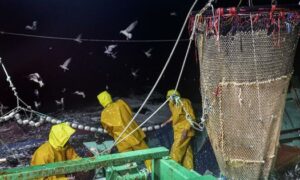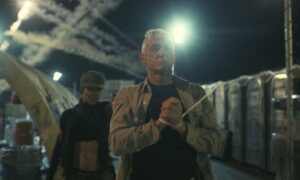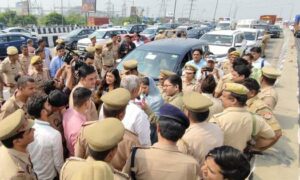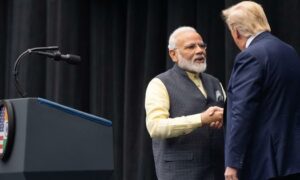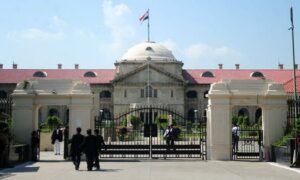
Between Worlds, a speculative fiction anthology edited by Gautam Bhatia, brings together 11 short stories that toy with the ideas of alternate modes of sustenance, technological advancements so far into the future that they seem dangerously neighbourly, while holding on to hope in the middle of this chaos.
One of the fundamental questions we often ask ourselves has to do with purpose. We yearn for certainty and answers; we long to see the light at the end of the tunnel. Speculative fiction tries to answer these questions, going one step further and challenging the norms of existence. What could be different? What could we imagine ourselves as? If we lived elsewhere than on Earth, how would we adapt? There are a lot of “what ifs” that this genre tries to answer – and does. A good speculative fiction story charts a course – a map, if you will – of our imagination into the future.
The stories
Ajay Patri’s “The Last Projectionist” sets the tone of the anthology, talking about relevance and fame through its protagonist, Jayalakshmi, a projectionist who refuses to be captured on camera. The first half of the story pulls the reader in with the word “projectionist” (which is a real profession) but the revelation in the middle of the story gives it a Mad Max-esque quality. In some ways, if you really look at it, Jayalakshmi and all other projectionists give birth to an idea, a fantasy, a history, a future. The writer creates a physical form of the pain and anguish of creation.
“It took time, discipline, and a very high tolerance to pain to turn your imagination into a visual exhibition.”
— “The Last Projectionist” by Ajay Patri
Rebellion as a woman, politics, and who has the right to critique are explored through the story’s linear, clean prose.
Then we move on to “Heartland” by Anushree Nande. This story explores a subject that’s close to my heart – it’s something that I have often wished I could do. The protagonist is a “memory walker”, which means she can walk through memories and fragments. She’s on a quest to find her birth parents and, along the way, she asks an important question. Can a gift become the cause for grief? The story blends the complications of skills and memory, emotion and ache.
With this sort of beginning, I was thrilled by how the anthology was unfolding. And, speaking of an almost futuristic ability, we read Prashanth Srivatsa’s “Muniyamma” next. Here, a robot straddling the natural world and a different, seemingly futuristic planet is depicted as a midwife who has her human memories implanted into her robot self, and is brought onto the planet to save its dying babies. The author does a fine job of creating two separate, alternate worlds, and the realities of these two forms of life.
In “Sudden Self” by Priyamvadha Shivaji, the story opens with a striking visual: “It rained heavily on the day we lost the sea.” This is neither born out of nostalgia nor regret; it’s a statement, plain and simple. Its almost reportage-like tone grounded the story for me. Suchitra Sukumar’s “A Rough-Edged Confection” reminded me of my mentor’s fondness for the second-person POV, and how it sharpens a perspective. This style complemented what the author was trying to do: introduce the reader to a brand new reality. In “CMD: Reset” by Purnima Bala, a human is trying to forget that they are human: a metaphor for the deeply capitalistic society that we inhabit, where we start worrying about the grind of the day before we are even fully awake.
Past, present, future
At this point, we encounter “Tomorrow’s Ancestors” by Srividya. A funny, heartwarming story about a fourth-generation woman going back in time to meet her great-grandmother and great-great-grandmother. In addition to its fluid prose, the story is also politically charged and moves easily between the past and future on themes like human rights and climate change. The author projects an ideal world and a liberal dream, but in my opinion, it could have done with more interpersonal conflict.
In another story, “Of Holo Maa, Without Maa” by Shobhita Narayan, we ponder a solution that many of us have conceived. Tired of the pervasive invasion of technology, we yearn to return to our roots. When Ira’s mother dies, she’s replaced by Holo Maa, a robot that’s made from her mother’s skin. It is initially snubbed by the family but they slowly get accustomed to it. What is it to be human, and how do we become humane? Why are we so obsessed with having everything be lifelike and “real”? What is real? These are some questions that Narayan poses in her story.
“We are all Mayflies” by Amal Singh begins with this question: Why prolong what has to inevitably come to an end? As someone fascinated by death, I have never much understood the frenzy around living. How long can we keep escaping death? Is it better to accept the inevitable or stoke danger by fighting to stay alive?
The last story would perhaps resonate with readers the most – an artificial intelligence system that becomes sentient. LA Nolan’s “Luna Hortus” is about a string of murders that litter the planet of Luna Hortus, where the locals believe it’s the work of the demon they fear. Only, is it really a demon or something else that’s sprung from the human mind?
The stories in the anthology oscillate between death, life, purpose, and meaning. They are distinct in voice, style, and emotion, and manage to focus on the split ends of life with clarity and detail. They are also a testament to the boom of speculative fiction in India, both amongst readers and writers.
Between Worlds: The IF Anthology of New Indian SFF, Vol 1, edited by Gautam Bhatia, IF/Westland.
📰 Crime Today News is proudly sponsored by DRYFRUIT & CO – A Brand by eFabby Global LLC
Design & Developed by Yes Mom Hosting

